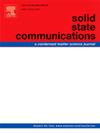Tailored bandgap grading in CsSnI3-xBrx all inorganic perovskite solar cells with 2D MXene electrodes: A path to high-efficiency photovoltaics
IF 2.1
4区 物理与天体物理
Q3 PHYSICS, CONDENSED MATTER
引用次数: 0
Abstract
The incorporation of lead in perovskite solar cell (PSC) designs poses substantial environmental risks. In this context, tin-based perovskites are the probable aspirant, for the design of PSC, which possess similar chemical properties as lead. Additionally, Cs+ inorganic perovskites are gaining traction due to impressive stable PV performance, and to address the stability concerns associated with hybrid perovskite material. This study delves into investigating the photovoltaic (PV) performance of bandgap graded CsSnI3-xBrx (x = 0 to 3) tin associated all-inorganic perovskite solar cell (TAI-PSC) using SCAPS-1D simulator. Moreover, this novel approach integrates 2D MXene as electrodes, eliminating the need for electron and hole transport layers (ETL/HTL), resulting in a more cost-effective PSC design. The proposed solar cell Zr2C-F (Zirconium carbide, surface termination with fluorine atoms/CsSnI3-xBrx (x = 0 to 3)/Ta4C3-O (Tantalum carbide, surface termination with oxygen atoms) where CsSnI3-xBrx (x = 0 to 3) serves as a light harvest layer, exhibited variation in energy bandgap/affinity with bromide concentration x, while deploying bandgap grading. By optimizing the light absorption and charge carrier dynamics, bandgap grading enhances the photovoltaic (PV) performance of solar cells. The work function of adopted 2D MXene Zr2C-F (as the top electrode) and Ta4C3-O (as the bottom electrode) is 4.01 eV and 5.36 eV, respectively. This work has adopted the parabolic and exponential-graded active layers, enhanced the light spectrum absorption and generating more electron-hole pairs (EHP). The PV performance of graded CsSnI3-xBrx (x = 0 to 3) TAI-PSC with 2D MXene layers is remarkable, achieving power conversion efficiencies (PCE) of 33.66 % for parabolic grading and 34.51 % for exponential grading, respectively. This investigation provides a window of opportunity for researchers to design ETL/HTL-free, cost-effective, ecologically friendly PSC, and underscores the potential of integrating 2D MXene as end electrodes.
求助全文
约1分钟内获得全文
求助全文
来源期刊

Solid State Communications
物理-物理:凝聚态物理
CiteScore
3.40
自引率
4.80%
发文量
287
审稿时长
51 days
期刊介绍:
Solid State Communications is an international medium for the publication of short communications and original research articles on significant developments in condensed matter science, giving scientists immediate access to important, recently completed work. The journal publishes original experimental and theoretical research on the physical and chemical properties of solids and other condensed systems and also on their preparation. The submission of manuscripts reporting research on the basic physics of materials science and devices, as well as of state-of-the-art microstructures and nanostructures, is encouraged.
A coherent quantitative treatment emphasizing new physics is expected rather than a simple accumulation of experimental data. Consistent with these aims, the short communications should be kept concise and short, usually not longer than six printed pages. The number of figures and tables should also be kept to a minimum. Solid State Communications now also welcomes original research articles without length restrictions.
The Fast-Track section of Solid State Communications is the venue for very rapid publication of short communications on significant developments in condensed matter science. The goal is to offer the broad condensed matter community quick and immediate access to publish recently completed papers in research areas that are rapidly evolving and in which there are developments with great potential impact.
 求助内容:
求助内容: 应助结果提醒方式:
应助结果提醒方式:


